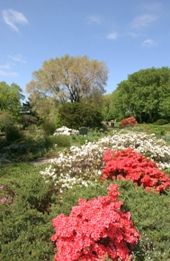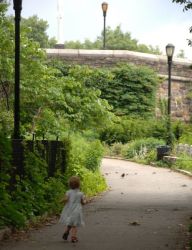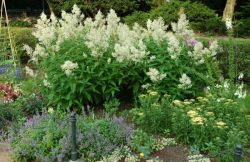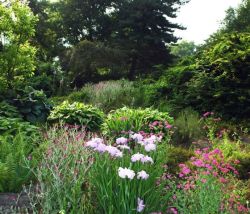Fort Tryon Park
The Daily Plant : Thursday, July 31, 2014
The Gardens Of Fort Tryon Park

With the New York City summer in full force, it’s time to stop and smell the roses - not to mention the lilies, verbena, and hostas and much more at one of our park gardens.
While many of our parks boast impressive gardens, two of the most eye-pleasing can be found nestled in Fort Tryon Park in upper Manhattan: the Heather Garden and the Alpine Garden.
Both were conceived by Fredrick Law Olmsted, Jr., whose father was the co-designer of Central and Prospect Parks, who designed the gardens with the natural landscape in mind. He embraced the slopes, views, and native plant life to create an oasis that fit perfectly in the topographically rich area.
The Heather Garden is the largest garden with unrestricted public access in New York City. While named for its large population of heathers, the garden is brimming with a large and diverse spread of vibrant plant life. Home to more than 500 varieties of beautiful perennials and shrubs, the garden displays an alluring tapestry of colors and hues. As you wander through the winding paths, enjoy the views of the Hudson River and New Jersey Palisades as you breathe in the diverse aromas. And make sure to keep an eye out for butterflies and hummingbirds - the garden is renowned for attracting these charming creatures.
While the Heather Garden is known for its flourishing plant life, the Alpine Garden has a different personality altogether. Imagined as an intimate collection of rustic stone staircases, Olmsted Jr.'s design was the first of its kind for a public park. Olmsted used the already existing coarse terrain to piece walkways up and down the slope between Broadway and the Cloisters. Created using a large variety of decorative rocks and low-lying plants adapted to a rough terrain, the unique façade is an interesting contrast to the Heather Garden. The rocks used in the garden contain prominent minerals such as quartz, feldspar, mica, and even some smatterings of garnet. In keeping with preservation of the already existing landscape, some of the stones used in the construction of the garden came from the rock excavated in the construction of Fort Tryon Park and the nearby A-train subway tunnel. Take in the wide array of colors from the rocks and plants as you take your journey through the many bends of the garden.
While you can explore both of these gardens on your own, the Fort Tryon Park Trust also offers fun and enriching tours to enhance your park experience. On these tours, you can delve into the history of the park, learn about the native plant life, and discover the secrets of the area. These tours are offered the first Sunday of every month at 1 p.m. and are a great way to get the most of the park experience, so make sure to check out nyc.gov/parks for more information or www.FortTryonParkTrust.org
If you need to refuel during your wanderings, make a stop at the New Leaf Restaurant & Bar. Re-opened in 2001 after substantial renovations, the restaurant now offers a wide variety of sandwiches, salads, and wraps, in addition to several fine dining options. Enjoy your meal in the tranquil setting of the outdoor patio.
And if you don’t have time this summer to visit these gardens, don’t fret! Appropriately referred to as the “Park for all Seasons,” the gardens host a vibrant plant life all year-round. Past renovations of the gardens have extended the bloom time to ensure year-long horticultural interest and diversity.
And make sure you check out the other garden treasures that our city holds like the Queens Botanical Garden alongside Flushing Meadows Corona Park or Conservatory Garden in Central Park. Get outdoors and visit a garden!
By Jennifer M. Hoppa, Administrator of Northern Manhattan Parks
and the Executive Director of the Fort Tryon Park Trust
QUOTATION FOR THE DAY
"Be not ashamed of mistakes and thus make them crimes."
Confucius
(551 BC - 479 BC)
Check out your park's Vital Signs
Clean & Safe
Green & Resilient
Empowered & Engaged Users
Share your feedback or learn more about how this park is part of a
Vital Park System









